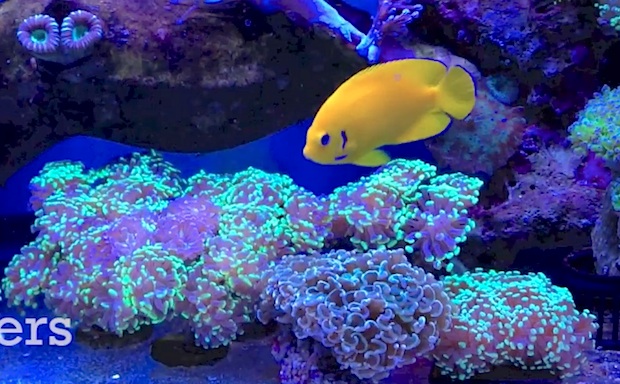We’ve always thought it was odd that our marine fish get discretely divided into the reef-safe and non reef-safe camps because as we’ve seen time and time again, it’s very possible to keep predators in a reef tank; they don’t mess with corals but they might eat a lot of other things. But what to do about known coral-eating culprits?
Well the lemonpeel angelfish is definitely one of those species that likes to munch on a range of coral species. We’ve made no efforts to hide our love for the blue-eyed lemonpeel angelfish from Cocos Island in the Indian Ocean and like you’d expect, this individual loves to gnaw on precious corals, especially the most precious chalices, zoanthids, psammocora, pavona and several other corals which used to be in its aquarium.
Undaunted, and with no other tank to place this specimen, we began experimenting with different corals that might not appeal to this individual’s palate. To our surprise, it didn’t take long to fill this 30 gallon aquarium end-to-end with species of corals that this Cocopeel simply doesn’t recognize as food.
We know that gorgonians and alcyonid soft corals are chock-full of noxious substances that would hopefully be distasteful, and we managed to introduce a couple colonies of each. We were pretty confident that the gorgonian would be ignored, but those well-extended emerald green polyps on this Sarcophyton just look juicy, but to date not a single one has even been sampled.
Xenia and Cespitularia are doing really well and two types of Caulastrea were also tried with mixed results. A colony of the small-headed neon green Caulastrea curvata was promptly chomped on, while the much larger corallite, and fleshier, Caulastrea tumida was completely left alone.
The real success coral in this reef tank for a coral-eating fish is the Euphyllia. It was a small head of Euphyllia parancora, branching hammer coral, that was introduced to the lemonpeel’s dedicated aquarium as a lark, because it grows like a weed and we have plenty to go around. Surprisingly, the initial two-headed piece was ignored and over time we’ve transferred over a veritable field of Euphyllia species corals and now it looks like our coral-eating Centropyge is living in a tank full of corals that are going completely unscathed by a known coral eating fish.
It just goes to show you that when it comes to reef fish and aquarium corals, reef-safe is much less descriptive than it should be, and there’s still plenty of reef aquarium rules left to be broken.




Hey did this set up ever work out? I have the same fish and trying to figure out something similar? Find any issues later on with fish/ tank?